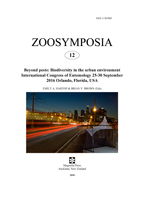Abstract
The history of people living with insects, spiders and their relatives is long, probably as long as humans have been using fixed domiciles (e.g., caves). Studies of caves inhabited by prehistoric people 26,000 years ago suggest arthropod pests already lived alongside our ancestors in those caves (Araújo et al. 2009). Arthropods are also both abundant and diverse in domestic archaeological sites from agricultural civilizations in Egypt, Israel and Europe (Switzerland and Greenland). Arthropods are especially common in association with stored food products and livestock (Panagiotakopulu 2001; Overgaard Nielsen, Mahler, and Rasmussen 2000; Kislev, Hartmann, and Galili 2004).
References
Ackley, J.W., Wu, J.G., Michael, J. Angilletta, Jr., Soe, W. M. & Brian, S. (2015) Rich Lizards: How Affluence and Land Cover Influence the Diversity and Abundance of Desert Reptiles Persisting in an Urban Landscape. Biological Conservation, 182 (February), 87–92.
https://doi.org/10.1016/j.biocon.2014.11.009
Araújo, A., Ana, M.J., Karl, R. & Luiz, F.F. (2009) Paleoparasitology of Chagas Disease: A Review. Memórias Do Instituto Oswaldo Cruz, 104 (July), 9–16.
https://doi.org/10.1590/S0074-02762009000900004
Bertone, M.A., Misha, L., Keith, M.B., Tara, L.F.M., Robert, R.D. & Michelle, D.T. (2016) Arthropods of the Great Indoors: Characterizing Diversity inside Urban and Suburban Homes. PeerJ, 4 (January), e1582.
https://doi.org/10.7717/peerj.1582
Cohn, R.D., Samuel, J.A., Renee, J., Reid, L.H. & Zeldin, D.C. (2006) National Prevalence and Exposure Risk for Cockroach Allergen in U.S. Households. Environmental Health Perspectives, 114 (4), 522–526.
https://doi.org/10.1289/ehp.8561
Hope, D., Gries, C., Zhu, W.X., Fagan, W.F., Redman, C.L., Grimm, N.B., Nelson, A.L., Martin, C. & Kinzig, A. (2003) Socioeconomics Drive Urban Plant Diversity. Proceedings of the National Academy of Sciences of the United States of America, 100 (15), 8788–8792.
https://doi.org/10.1073/pnas.1537557100
Kinzig, A.P., Warren, P., Martin, C., Hope, D. & Katti, M. (2005) The Effects of Human Socioeconomic Status and Cultural Characteristics on Urban Patterns of Biodiversity. Ecology and Society, 10 (1), 23.
https://doi.org/10.5751/ES-01264-100123
Kislev, M.E, Hartmann, A. & Galili, E. (2004) Archaeobotanical and Archaeoentomological Evidence from a Well at Atlit-Yam Indicates Colder, More Humid Climate on the Israeli Coast during the PPNC Period. Journal of Archaeological Science, 31 (9), 1301–1310.
https://doi.org/10.1016/j.jas.2004.02.010
Han, L. & Wilkins, K.T. (2014) Patch or Mosaic: Bat Activity Responds to Fine-Scale Urban Heterogeneity in a Medium-Sized City in the United States. Urban Ecosystems, 17 (4), 1013–1031.
https://doi.org/10.1007/s11252-014-0369-9
Leong, M., Bertone, M.A., Bayless, K.M., Dunn, R.R. & Trautwein, M.D. (2016) Exoskeletons and Economics: Indoor Arthropod Diversity Increases in Affluent Neighbourhoods. Biology Letters, 12 (8), 20160322.
https://doi.org/10.1098/rsbl.2016.0322
Leong, M., Bertone, M.A., Savage, A.M., Bayless, K.M., Dunn, R.R. & Trautwein, M.D. (2017) The Habitats Humans Provide: Factors Affecting the Diversity and Composition of Arthropods in Houses. Scientific Reports, 7 (1), 15347.
https://doi.org/10.1038/s41598-017-15584-2
Luck, G.W., Smallbone, L.T. & Sheffield, K.J. (2013) Environmental and Socio-Economic Factors Related to Urban Bird Communities.” Austral Ecology, 38 (1), 111–120.
https://doi.org/10.1111/j.1442-9993.2012.02383.x
Overgaard, N.B., Mahler, V. & Rasmussen, P. (2000) An Arthropod Assemblage and the Ecological Conditions in a Byre at the Neolithic Settlement of Weier, Switzerland. Journal of Archaeological Science, 27 (3), 209–218.
https://doi.org/10.1006/jasc.1999.0448
Panagiotakopulu, E. (2001) New Records for Ancient Pests: Archaeoentomology in Egypt. Journal of Archaeological Science, 28 (11), 1235–1246.
https://doi.org/10.1006/jasc.2001.0697
Robinson, W.H. (2005) Urban Insects and Arachnids: A Handbook of Urban Entomology. Cambridge University Press.
https://doi.org/10.1017/CBO9780511542718
Wang, C.L., El-Nour, M.M.A. & Bennett, G.W. (2007) Survey of Pest Infestation, Asthma, and Allergy in Low-Income Housing. Journal of Community Health, 33 (1), 31–39.

